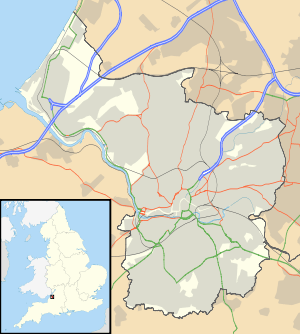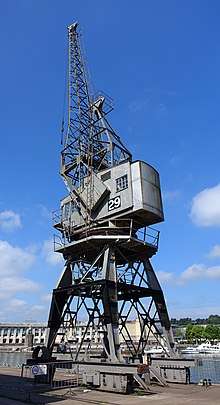M Shed
M Shed is a museum in Bristol, England, located on Prince's Wharf beside the Floating Harbour in a dockside transit shed formerly occupied by Bristol Industrial Museum. The museum's name is derived from the way that the port identified each of its sheds. M Shed is home to displays of 3,000 Bristol artefacts and stories, showing Bristol's role in the slave trade and items on transport, people, and the arts. Admission is free.
.jpg) | |
 Location within Bristol | |
| Established | 2011 |
|---|---|
| Location | Princes Wharf, Wapping Road, Bristol BS1 4RN, England, United Kingdom |
| Coordinates | 51.4473°N 2.5986°W |
| Visitors | 769,474(2018/19) |
| Website | www |
The museum opened in June 2011, with exhibits exploring life and work in the city.[1] In its first year, 700,000 people visited the new museum.
Normally moored in front of the museum is a collection of historic vessels, which include a 1934 fireboat (the Fire-float Pyronaut), and two tugboats (Mayflower, the world's oldest surviving steam tug, and John King, a 1935 diesel tug).
The museum contains a shop, learning space and cafe.
History

On the quayside outside the museum are four electrically powered cargo cranes built in 1951 by Stothert & Pitt. Three of these cranes are operational and operate some weekends. A short distance to the west is a much older crane, the sole surviving operational example of a Fairbairn steam crane. Built in 1878,[2] also by Stothert & Pitt, it was in regular use until 1973 loading and unloading ships and railway wagons with loads up to 35 tons. It has been restored and is in working order, operating on some bank holidays and the Bristol Harbour Festival.[3]
The Bristol Industrial Museum closed in 2006 and was transformed into the M Shed. The conversion was designed by Lab Architecture Studio.[4] It was expected to cost £27 million including a grant of £11.3 million from the Heritage Lottery Fund.[5] Another £1.39 million of HLF funding was announced in April 2011.[6] It reopened in June 2011. In its first year, 700,000 people visited the new museum.
Bristol Harbour Railway offers train rides along the quayside[2] on selected weekends, using restored steam locomotives and rolling stock.
Moored in front of the new museum is the collection of historic vessels, which included the 1934 fireboat Pyronaut[2] and two tugs: John King built as a diesel tug in 1935, and Mayflower, the world's oldest surviving steam tug, built in 1861.[7][8]
Galleries
There are three main galleries: Bristol Places, Bristol People and Bristol Life, each telling a story of Bristol, and containing a mixture of media.
Among the 3,000 exhibits of material on display are models of Nick Park's Oscar-winning animated duo Wallace and Gromit, a 10m long mural by local graffiti artists, and pink spray painted record decks (1980) courtesy of Massive Attack,[9] the trip hop trio from Bristol. The band's experimental sound would play a big part in the formation of the city's club scene in the 1980s and 1990s.
On display are newspaper clippings from the city's landmark political episodes, including a victory for the fight against racial prejudice in 1963 when a group of West Indian workers led a bus boycott after the Bristol Omnibus Company refused to recruit black workers.
A centrepiece of the galleries is a huge mural entitled Window on Bristol, painted by local artists Andy Council and Luke Palmer. It depicts Bristol's buildings in the form of a huge graffiti-esque dinosaur.[10]
There is also a temporary gallery displaying changing exhibitions throughout the year.
Aviation, the museum also contains: a Mignet HM.14, a piece of the Bristol Brabazon,[11] a one-third scale model of a Rolls-Royce Pegasus engine, a Rolls-Royce/Snecma Olympus 593 engine and a Bristol Proteus Mk.255 engine.
References
- "M Shed". Bristol City Council. Retrieved 5 August 2013.
- "M Shed - Culture24". www.culture24.org.uk. Retrieved 19 January 2018.
- "The steam crane". Farvis. Archived from the original on 28 September 2007. Retrieved 18 August 2006.
- "M Shed Bristol Museum / LAB Architecture Studio". Arch Daily. 2 July 2011. Retrieved 19 February 2013.
- "Date set for M Shed to open doors". Bristol Evening Post. 2 January 2011. Retrieved 3 April 2011.
- "Bristol's M Shed gets extra £1.39m from lottery fund". BBC News Online. 13 April 2011.
- "Mayflower, ST". Historic Steamers. Archived from the original on 4 March 2001. Retrieved 18 August 2006.
- "Preserving Vessels in a Diverse Local History Museum". Third International Conference on the Technical Aspects of the Preservation of Historic Vessels. Retrieved 18 August 2006.
- Lachno, James (21 June 2011). "M Shed, Bristol, review". Retrieved 19 January 2018 – via www.telegraph.co.uk.
- James Lachno M Shed, Bristol, review, The Telegraph, 21 June 2011. Retrieved 10 November 2011.
- http://museums.bristol.gov.uk/details.php?irn=141002